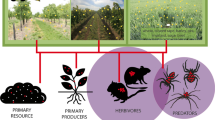Abstract
We tested the hypothesis that phytophagous insects would have a strong top-down effect on early successional plant communities and would thus alter the course of succession. To test this hypothesis, we suppressed above-ground insects at regular intervals with a broad-spectrum insecticide through the first 3 years of old-field succession at three widely scattered locations in central New York State. Insect herbivory substantially reduced total plant biomass to a similar degree at all three sites by reducing the abundance of meadow goldenrod, Solidago altissima. As a result, Euthamia graminifolia dominated control plots whereas S. altissima dominated insecticide-treated plots by the third year of succession. S. altissima is the dominant old-field herbaceous species in this region but typically requires at least 5 years to become dominant. Past explanations for this delay have implicated colonization limitation whereas our data demonstrate that insect herbivory is a likely alternative explanation. A widespread, highly polyphagous insect, the xylem-tapping spittlebug, Philaenus spumarius, appeared to be the herbivore responsible for the reduction in standing crop biomass at all three sites. Insect herbivory typically caused little direct leaf tissue loss for the ten plant species we examined, including S. altissima. Consequently, the amount of leaf area removed was not a reliable indicator of the influence of insect herbivory on standing crop biomass or on early succession. Overall, we found a strong top-down effect of insect herbivores on biomass at several sites, so our results may be broadly applicable. These findings run counter to generalizations that top-down effects of herbivores, particularly insects, are weak in terrestrial systems. These generalizations may not apply to insects, such as spittlebugs, that can potentially mount an effective defense (i.e., spittle) against predators and subsequently reach relatively high abundance on common plant species. Our results suggest that insect herbivory may play an important but often overlooked role during early old-field succession.
Similar content being viewed by others
Author information
Authors and Affiliations
Additional information
Received: 26 December 1998 / Accepted: 3 April 1999
Rights and permissions
About this article
Cite this article
Carson, W., Root, R. Top-down effects of insect herbivores during early succession: influence on biomass and plant dominance. Oecologia 121, 260–272 (1999). https://doi.org/10.1007/s004420050928
Issue Date:
DOI: https://doi.org/10.1007/s004420050928




